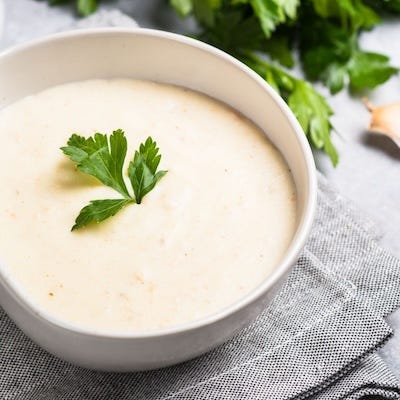Wow, are restaurants expensive these days. Even a quick-casual can take your breath away when they tell you the cost.
What makes matters worse is when the food isn’t so good.
Now, I’m not talking about getting food home, and it’s cold or soggy. That’s only part of it. What I’m talking about is food that is bad for your health. It’s bad for your health because it has to be - the food corporations add harmful ingredients to make it more attractive to you.
This is something I only truly noticed as I moved into a plant-based lifestyle. Let me explain.
Years ago, when my daughter declared herself vegetarian at the age of three, I didn’t understand the poor choices she faced when we went out to eat at restaurants I considered good.
I’d order her salads, and see if they could remove the meat. They’d think for a moment, nod, and deliver subpar food. Those salads had very little nutrition - they relied on the meat to make them appear “good.” But I didn’t see this because I was eating the things I liked, the things I thought were healthy.
My turning point came when I moved to vegetarianism. Very quickly, I became aware of just how bad restaurant food is. It’s what spurred my journey to start cooking …
Let’s start with this video by Michael Pollan - it’s only two minutes and worth your time. It effectively describes the differences between the way individuals and corporations cook.
While I believe everyone can benefit by cooking more at home, it’s imperative for plant-based eaters for a variety of reasons:
It gives you more nutritious meals
It helps you understand what you’re eating and how it impacts your body
It develops new skills
It gets you up close and personal with your food
This is your why. The “why” is fairly easy to understand - most people have a desire to get back in the kitchen, especially when they start paying attention to their food. But I still get questions all the time about how to develop a daily cooking habit.
Especially when you’ve got your own internal stories:
I hate cooking
I’m not a good cook
It intimidates me
I don’t like my cooking
It takes too much time
I just can’t do it at the end of a busy day
Did I hit one of your stories?
Then I’ve got solutions for you.
Developing a daily cooking habit is like any other task or project you take on. The more you do it, the better you get at it. You just have to do it to fall in love with it.
So, if you’ve got your own stories, read on. I’ve got some strategies for you to fall in love with your kitchen once again!
Step One: Let’s start by figuring out your story
Whether you shake your head yes or no reading the above points, you probably have internal stories that help prevent you from cooking regularly.
A big one for me was always centered around time. By the time I got home from a hectic day, the last thing I wanted to do was spend more time in the kitchen. More often than not, I grabbed the phone and ordered a pizza. Or loaded everyone into the car to head out to one of our favorite restaurants.
The more committed I became to my plant-based diet, the more time I spent analyzing where the real problem was.
Time is a function of preparedness. When I opened the cupboards and tried to pull a meal together, I found I was missing ingredients, or simply had no idea what recipe to follow.
It wasn’t time as much as being organized for cooking a meal. Change that one factor, and it changes everything.
Every day, you’ll need to decide how you feed your story. Do you want to stick with what you’ve always told yourself? Or do you choose to add a new chapter?
Step Two: Addressing the issue
When I finally went vegetarian, it became apparent that most chain restaurants fail at providing vegetarian meals. They’ll have one token entree to please you, and that’s usually loaded with cheese.
It also has very little flavor.
After one too many meals out, I started thinking about the money we were wasting. There had to be a better way! So I bought my very first vegetarian cookbook. I found a recipe and cooked. It wasn’t bad!
Of course, that meal turned into several per week, till eventually, eating out became the exception instead of the rule.
I get that it sounds easy on paper. In reality, it’s not quite that easy. But you do have to address the issue.
For me, timing was all about being unprepared. I’d stand in my kitchen at 5 o’clock, with no strategy in mind. That’s the wrong time to be thinking about meal planning.
So I took a different approach. I started by planning my meal first thing in the morning. If I needed a few items, I had plenty of time to stop by the grocery store. That’s morphed to where I am today, planning a week at a time. I’ll sit down on Sundays and plan a week in advance. That way, I can shop for the entire week in one shot.
It works for me. You have to work out what works for you.
Step Three: Start small
Are you already feeling overwhelmed? Don’t be. New habits are easy to release back into the universe if you don’t create structure around them. If you’re rarely in the kitchen, don’t make a plan to cook every single meal.
Instead, start with one day a week. I love Sunday meals because it’s the one day I’m usually home. It’s my “get stuff done around the house” day. So it’s also the day I’m most likely to throw a big pot of vegan chili on the stove, or whip up one of my lasagnas.
Then, when one day is easy, move to two. Eventually, you’ll do it more because of your love of cooking.
Oh, and make your “small step” fun. Build a special playlist you listen to only when you cook. Buy a special wine glass and use it only when spending time in the kitchen. Or maybe get two fancy cutting boards and knives, and invite your significant other to spend time with you in the kitchen. I get a lot of great conversations in the kitchen - my husband and I love cooking together. You can do it too!
Step Four: Leftovers are your friends
Okay, I mentioned my vegan chili above because I make it all the time. I love it! And I don’t just make a little; I make a ton of it. Why? Because it makes the best leftovers, and leftovers are scrumptious for easy weekday lunches.
I hate the “100 best recipes” posts you can find online. They’re confusing and make you feel like you need variety every single day of the month. Not true!
Start with a few recipes you love. Make them frequently – once a week. That’s okay. And if you make a lot of it, you’ll have several meals.
Keep these as your mainstay items and cook them regularly. It gives you options.
Here’s a secret: I’ve been cooking the same vegan chili for nearly a decade! I love it! I have the recipe memorized. And I can experiment with it too when I like by adding something new - a new spice, a different bean, or a little more heat. This one recipe has taught me the basics of all kinds of cooking - I’ll be eating it for many years to come …
Step Five: Go slowly
I’ve found I’m all-in on new habits. I want to go as fast as I can. Trouble is, if you go too quickly, you burn out, and quit the practice altogether. I learned this long ago, and take a different approach to habits today.
Start with one meal a week. Then move to two. Do it for a few weeks before you proceed to three. On and on, celebrating your wins along the way.
And when you miss a day? Don’t feel like failing. Instead, get right back at it. It’s okay!
Step Six: Start with food you enjoy
What’s your favorite food right now? The food you think you’ll miss most when you move to plant-based eating?
It’s time to find a plant-based recipe you fall in love with to replace it.
I LOVE Pad Thai. Love it! But I could never get my plant-based recipes to come close to my favorite restaurant.
I kept searching, looking for one I liked. Then, voila, I found it. I make it regularly now.
Whatever your favorite food is, go searching for a plant-based replacement. Don’t worry if it takes you a while to find it; that can be part of the fun.
And when you find it – you’ll anticipate being able to whip it up in your kitchen repeatedly!
Step Seven: Share it with others
Do I hear grumbling? One of the most challenging parts of switching to plant-based is preparing foods for others who aren’t. They grumble. They moan and complain … Until they try it.
By taste alone, I’ve converted so many people to plant-based meals, at least part-time.
See, people often have the impression that plant-based foods are boring salads with zero taste. It simply isn’t true.
Here’s what you do. Find a favorite – one you fall in love with. Make that your go-to meal. Then share it with people. Bring it to potlucks. Bring it to family get-togethers.
I have a neighbor who wanted a hearty winter soup that made her feel like she was back in her hometown. I told her about my baked potato soup. She couldn’t wait to try it. It’s filled with potatoes, almonds, nutritional yeast, tempeh bacon – yes, it’s actually pretty good for you. And the taste’s incredible! She made a batch, and can’t stop raving about it. She’s brought it to several potlucks; people can’t believe it’s vegan. No butter, cheese, fatty bacon, milk, or sour cream in this recipe.
When you produce a great recipe, it boosts your confidence. When you bring it along to a potluck and share it – and people LOVE it – you start falling in LOVE with your kitchen. It’s amazing what you can do.
Step Eight: Enjoy the process
Like any habit, cooking takes time.
I remember a time when we declared our birthdays as a night we could pick any restaurant to visit for dinner. These days, we enjoy birthday dinners at home. Because we absolutely love what we cook. It’s good; it’s better for us … what’s not to love?
But this has been a process. I didn’t start out as a good cook. Yes, I consider myself to be a good cook today. I enjoy it.
And that’s really the key. See, we each have 24 hours a day. What you choose to do with those 24 hours is up to you.
Spending time in a car getting to a restaurant, waiting for reservations, and getting a meal that’s just okay – that isn’t something I’m interested in anymore. With the habits I have down now, I make cooking a part of my nightly process. And with my family joining me in the kitchen, we turn it into an event. We laugh, joke, and inspire each other.
Ask yourself: What would make it more enjoyable? Any little thing is okay. A new pan. A new cookbook. (I’ve got you covered there. You have jumped into some of my Cookbook Club posts, haven’t you?)
While I don’t believe in going all-in upfront, I do think you should commit to long-term planning. And make it something you ENJOY doing, not something you have to do …
Step Nine: Enjoy the benefits!
Head back up and watch the video again. Restaurants or processed food can’t nurture your health. It’s not what they’re designed to do.
Right now, I’ve become very aware of the food I bring into my home. I select only the best ingredients. And it shows up in every way possible.
My skin is clear. I sleep better. I feel healthy inside and out. I feel full when I eat great food – no empty calories here.
This takes time. Your body has to get used to the new way you eat. But once it does – you’ll never eat another way.
Step Ten: Share!
I started Roots! specifically to share all of the knowledge I’ve gained over the last three decades.
I’m a completely different person than I was back then. On the night my dad died at the age of fifty-four, I had no idea I’d be who I am today. That I would be this aware of food, this in control over my health, and leading a Gorgeous Wellthy Life!
I promise you’ll be excited to share when you get there, too.
So give it a shot.
The benefits are worth it. Why not start moving to a plant-based lifestyle today! I’ll even give you a recipe you’re gonna love. Cause I’ve shared this one around, and everyone loves it. See what you think!
Vegan Baked Potato Soup
Ingredients:
1 cup raw whole almonds, soaked, peeled
3 cups veggie broth
1 pound russet or red potato
¼ cup nutritional yeast
Salt and pepper to taste
Roasted potatoes:
1 cup diced potatoes
¼ cup nutritional yeast
1 teaspoon extra virgin olive oil
Salt and pepper to taste
Extras:
Chives, chopped
Tempeh bacon, chopped
Directions:
Place raw almonds in a bowl, pour boiling water over them and leave them sit for an hour.
For the roasted potatoes, heat oven to 400 degrees. Toss diced potatoes in olive oil and nutritional yeast. Lay flat on a baking sheet and add salt and pepper. Roast 20 minutes or until tender and crispy.
While potatoes are roasting, peel the one pound of potatoes and chop them into small wedges. Add to boiling water and cook until tender. Drain away water.
Drain and rinse the almonds. Remove any additional skins – they should easily pop out of the skin by squeezing them between your thumb and forefinger.
Place almonds, boiled potato, veggie broth, nutritional yeast, and salt and pepper in a high-powered blender, or use an immersion blender until smooth and creamy. You may need more or less veggie broth, depending on your desire. Season to taste.
Divide soup into serving bowls. Top with roasted potatoes, chives, and tempeh bacon. Enjoy!
p.s. Did you like this message? It would mean a lot to me if you’d press the ❤️ below if you liked it, left a comment 💬, or shared it with a friend. I’m trying to grow this publication, and I depend on people like you to do so!
And if you’re new here, Welcome! 💐 I’d love to start sharing my message with you if you’re interested in all things plant-powered, proaging, or finding kitchen joy. Subscribe … and then explore my entire archive! Glad to share with you! 🙋🏼♀️












